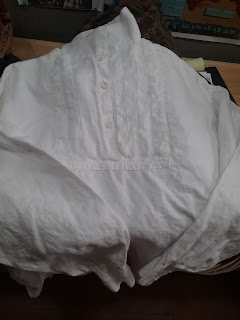Shirt the first:
 |
| Linen shirt |
 |
| Cotton shirt. |
The first shirt is made entirely from linen, the second from pimatex cotton. At the request of the wearer, I made a few alterations to the basic pattern:
- Reducing the length by ~8". Last time I made this up, the recipient also requested it be shortened.
- Using all one fabric (calls for linen bosom and cuffs, with the rest of the shirt in cotton)
- Adding a third button at the top of the pleated bosom. The cravat, in theory, holds the collar in place, but after trying the first shirt out, the wearer requested an extra button at the top to stabilize things.
- For the cotton shirt, the collar was lengthened.
Thoughts on this pattern:
Generally, I like this pattern. The shirt has a good shape, and there's some customization options presented (alternatives to the center front pleats), with citations. It's also copied from an original shirt, with all the instructions for hand-sewing it. That being said, the pattern is not without it's quirks--such as the tiny triangles pieced into the sleeve, which serve no discernible purpose* except for making the seam hard to fell. The instructions are mostly clear about each step, but there are times when additional information would be useful. For instance, it's never specified where the front bosom pieces should lap left over right or right over left; the pleats themselves are to be basted, but no future step mentions permanently stitching the pleats or removing the basting thread.
Twice I've made it up, and struggled to get everything cut from the allowed material; the third time, I had a lot left over. For future use, instead of following the pattern envelop guides, I would establish the wearer's preferred length in advance, and then lay out all the pattern pieces to determine the amount of material needed.
*These are not gores for increasing mobility at the shoulder: they attach flat the sleeve, to make it more of a trapezoid shape. The same result can be achieved by overlapping the pattern pieces and cutting out the sleeve as one piece (less seam allowances). My only guess is that the original garment was pieced due to fabric limitations.
No comments:
Post a Comment
Thanks for commenting!